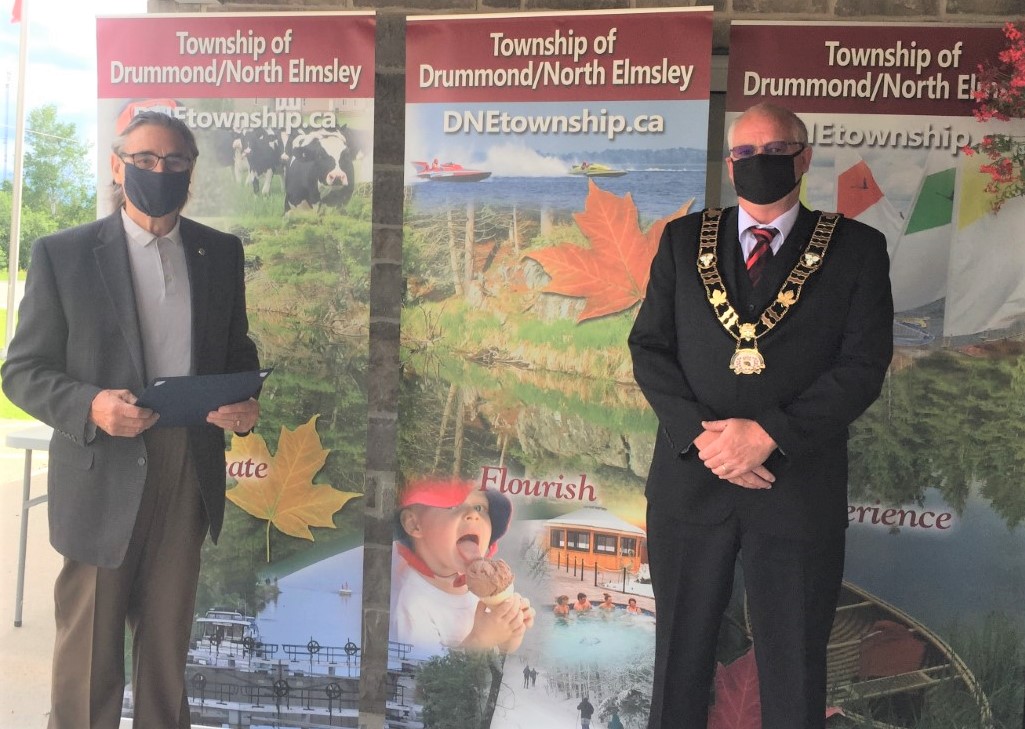Kyra Dobbie
Watershed Discovery Day at the Market
Visit the Farmer Market on August 14, 2021 at the Crystal Palace in Perth. Help Celebrate the 20th Anniversry of the Tay Wateshed Discovery Day. With lots of fun for the kids with Story Time, Paddling Puppeteer Shows, Hands-On Displays, and a Model Wetland.
Perth & District Library Expands Opening Hours and Services

The Perth and District Union Public Library is pleased to announce newly expanded hours, starting Tuesday August 3. The new hours are Monday 10am-5pm, Tuesday/Wednesday/Thursday 10am-7pm, Friday 10am-5pm and Saturday 10am-4pm.
“Now that we have moved into Step 3 of Ontario’s Re-opening plan, we’re happy to be expanding our hours to meet our community’s needs and continue to serve as a community hub”, said Erika Heesen, CEO/Chief Librarian.
In Step 3, the library is open to the public for browsing, with in-person programs and meeting rooms also available. One such program is the library’s annual Summer Literacy Program, which has 92 children from 7 local schools enrolled. Referred by their teachers, these children receive one on one tutoring from paid tutors who have received specialized training in literacy strategies. Another program open to everyone of all ages is the library’s Summer Reading Club. For each book you read, you get a ballot to enter to win prizes. For the kids, two lucky winners will ride away with a brand new bicycle generously donated by Canadian Tire in Perth. For teens and adults, they can win a gift certificate to a local business.
“It has been wonderful to see the energy of the children participating in the literacy program and the reading club”, said Heidi Taber, Children’s Library Specialist. “Everyone is so happy to attend in person. As of mid-July, we have 174 people signed up for the club and 419 kids’ ballots entered!”.
Registration and ballots for the Summer Reading Club and in-person programs are available online at www.perthunionlibrary.ca. Contact This email address is being protected from spambots. You need JavaScript enabled to view it. for inquiries about the TD Summer Reading Club and the Summer Literacy Program. To learn more about the services and programs offered by your library, visit www.perthunionlibrary.ca.
Health Unit Raises Awareness about Bats and Rabies
MEDIA RELEASE:
Leeds, Grenville and Lanark District Health Unit
July 22, 2020
Health Unit Raises Awareness about Bats and Rabies
Approximately three percent of bats carry the rabies virus. The most common signs of rabies in bats are the inability to fly and resting in unusual places such as the ground or floor. It is important to remember many of the bats that get into our homes are healthy bats and are looking for a way out.
Bats are nocturnal animals and feed most actively two to three hours following sunset. They are efficient pest controllers as they consume three times their body weight in insects per night. Bats select attics for nursery colonies, however, during the day they roost in trees and in buildings. Bats are usually born in June. Nests are not required as the young are able to fly and obtain their own food within three weeks. Hibernation occurs between November and March. Some species typically hibernate in attics of buildings while others prefer caves.
Diseases Bats May Carry
Bats do have the potential to carry diseases such as rabies and histoplasmosis, which can affect humans and animals. They may also transmit distemper and mange to household pets.
- Rabies is a disease caused by a virus that attacks the central nervous system, and is found in the saliva of infected animals. Rabies is fatal if left
- Histoplasmosis is a disease caused by a fungus that grows in soil contaminated with bat or bird droppings. Exposure to the fungus occurs when the soil is The disease primarily affects the lungs and can be fatal if left untreated. If you are cleaning areas where bat droppings have accumulated be sure to wear a protective mask and gloves and keep dust to a minimum.
Bat Encounters
Bat exposures: If a bat is carrying the rabies virus, there is a risk of it being transmitted to an individual when both the following conditions apply:
- There has been direct contact with a bat – direct contact with a bat is defined as the bat touching or landing on a person;
AND
- A bite, scratch, or saliva exposure into a wound or mucous membrane. If you are bitten by a bat or if saliva from a bat gets into your eyes, nose, mouth or a wound, wash the affected area thoroughly and get medical attention immediately. If the bat is available, the Health Unit can arrange for it to be tested for
In a child, any direct contact with a bat (i.e., the bat landing on or touching the child, including contact through clothes) could be considered a reason for vaccine administration, as a child may not be able to reliably communicate the encounter with the bat to determine the type of the contact (i.e., a bite, scratch or mucous membrane exposure).
If you have experienced a bat encounter and/or may have been bitten, contact 1‐800‐660‐5853 or on weekends call 613‐345‐5685.
Bat Proofing Your Home
Bat proofing your house is necessary when the bats are entering the living space of your home. It is advisable to contact a pest management company or a wildlife conservation agency for assistance with bat‐proofing your home.
If you find a bat in your home and there was no human or animal contact, the bat can be released to the outdoors. Wear thick gloves when handling the bat to avoid being bitten.
Rabies can also affect pets; to protect your pet from rabies it is important to vaccinate them. Rabies vaccination is mandatory in Ontario for domestic cats and dogs. The Health Unit, in Partnership with local Veterinarians and Municipalities, will be holding Rabies Vaccination Clinics on September 22 and 29, 2021. The cost is $20.00 per animal; please visit our website for more information about our Rabies Clinics times and locations.
Related Links
- Bats – Health Canada
- Keeping Bats Out of Your House – Centers of Disease Control and Prevention
- Ministry of Natural Resources
- Bat Conservation International
For media interviews, contact: Susan Healey, Communications Co‐ordinator, 613‐802‐0550 or Katie Jackson, Manager, 613‐812‐0416 or email This email address is being protected from spambots. You need JavaScript enabled to view it.
Seeking Volunteers to sit on the Ferguson’s Falls Community Hall Redevelopment Committee and the Pinewood Memorial Forest Trail Committee
The Township of Drummond/North Elmsley is Seeking Volunteers to sit on the
Ferguson’s Falls Community Hall Redevelopment Committee and the Pinewood
Memorial Forest Trail Committee
The Council of the Township of Drummond/North Elmsley is seeking several volunteers to sit on the following committees:
Ferguson’s Falls Community Hall Redevelopment Committee: The Township is considering either replacing or repairing the community hall. The committee will oversee the design of the hall. It is a short-term volunteer position that could last several months and will end once the hall is designed.
Pinewood Memorial Forest Trail: The Township is considering developing a trail across from the landfill site on Code Road. This project is subject to a funding application. It is a short-term volunteer position that will end once the trail has been designed.
Meetings will take place during the day and may be electronic meetings. You must be a resident of the Township to apply. The Township also encourages residents who identify in under-represented communities to apply including the following: Women, Indigenous People, Youth, Persons with Disabilities, Newcomers to Canada, Immigrants, Black Communities, Racialized Communities and LGBTQ2.
Please submit a letter of interest outlining your experience, skills and reasons why this volunteer position interests you by August 6, 2021 to the undersigned.
Cindy Halcrow, Clerk Administrator
Township of Drummond/North Elmsley
310 Port Elmsley Road
Perth ON K7H 3C7
613-267-6500 ext 220
or email This email address is being protected from spambots. You need JavaScript enabled to view it.
CLIMATE NEWSLETTER
Lanark County is developing a Climate Action Plan (CAP) to reduce corporate and community greenhouse gas (GHG) emissions. This plan will engage with the community and a variety of stakeholders to help prepare everyone for a changing climate. This plan represents the first step in creating an integrated approach to mitigating the impacts of climate change throughout the County of Lanark. The final objective of the CAP is to reduce GHG emissions by targeting emissions on multiple levels both within the corporation and the community.
Ken Fournier Senior of the Year 2021
Congratulations Ken Fournier!
June is Seniors Month in Ontario, and the Senior of the Year Award is given by Council to recognize an outstanding senior who, after age 65, enriches the social, cultural or civic life of the community. On June 22, 2021, Council presented long time resident Ken Fournier with this award. Ken is well known for his tireless volunteerism. Here is a list of some of the community organizations and events that Ken has been involved in:
 CANADIAN CANCER SOCIETY
CANADIAN CANCER SOCIETY
- Member since Jan 1994
- Canvas for donations
- helped raise money for the Maurice Grimes Lodge
CIVITAN CLUB OF PERTH
- Member 1965-2016
- Chaired the Fruit Cake Sales for Canadian District East
- Held the position of Governor and Club President many times.
- Countless hours he spent supported the club’s activities.
LANARK CIVITAN CLUB
- Member since 1999
- Club Treasurer for last 10 years
- Hall Rental Chair for 7 years
In addition, Ken (along with his wife) has given considerable time to all the Civitan activities:
COMMUNITY LIVING ASSOCIATION
- Served on Community Living Association board from about 2016-2018
- A non-profit organization supporting individuals with intellectual disabilities.
TOWNSHIP COUNCIL
- Ken serviced as a Councillor of Drummond Ward from 2010-2016
COMMITTEE OF ADJUSTMENT
- Committee member since 2010 to present.

